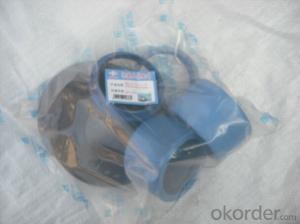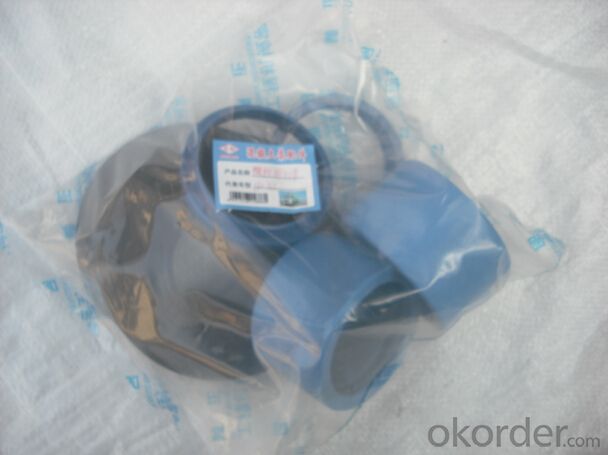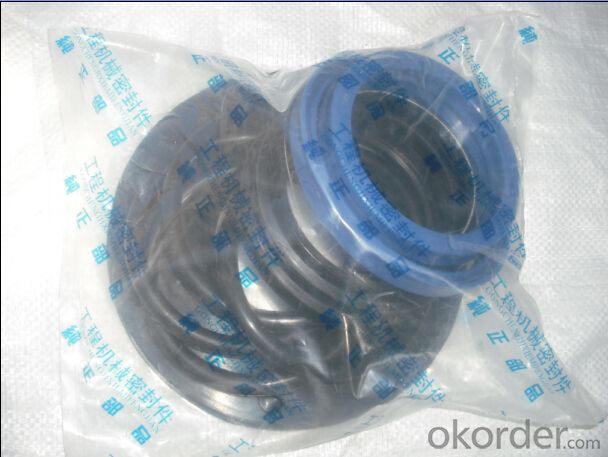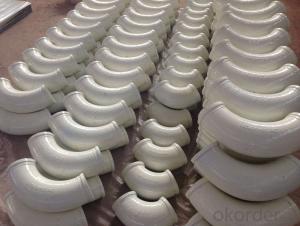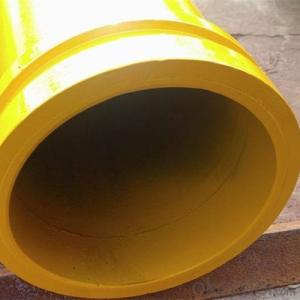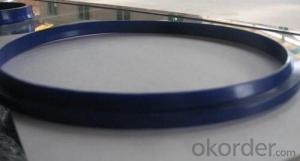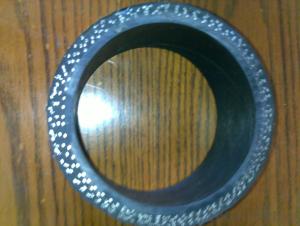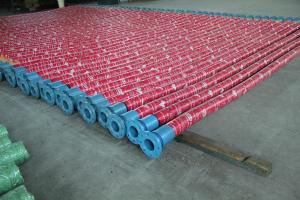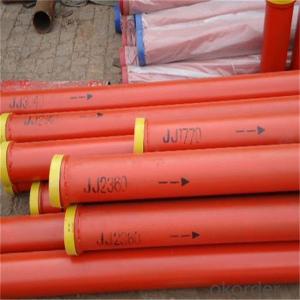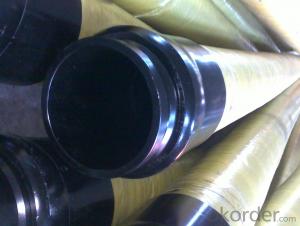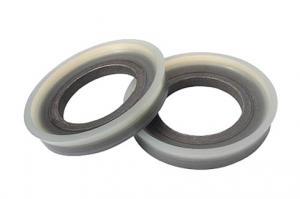ZOOMLION SEAL KIT FOR SHAFT HIGH QUALITY
- Loading Port:
- Tianjin
- Payment Terms:
- TT OR LC
- Min Order Qty:
- 1 set
- Supply Capability:
- 500 set/month
OKorder Service Pledge
OKorder Financial Service
You Might Also Like
ZOOMLION SEAL KIT FOR SHAFT
Specifications
Name: Concrete Pump Zoomlion seal kit
colors:black,blue,brown and so on
materials:NBR,BR,NR,SBR and EPDM
Concrete pump zoomlion seal kit for upper housing
seal kit for agitator motor
seal kit to outer housing
seal kit for discharge pipe
seal kit for delivery cylinder
seal kit for plunger cylinder
Seal kit for main cylinder
SEAL KITS PUTZMEISTER,SCHWING, SANY, ZOOMLION
SPARE PARTS FOR CONCRETE PUMP
--AGITATOR MOTOR
--S TUPE FOR 80&90
--MIXER SHAFT
--MIXER FLANGE
--ROCK VALVE
--PLUNGER CYLINDER
--SLEWING SHAFT
--SEAL KITS FOR CYLINDER
--DELIVERY PIPES & ELBOW
--DELIVERY PISTON RAM
--CLAMPS FOR SCHWING AND PUTZMEISTER
--SCHWING SPARE PARTS
--PUTZMEISTER SPARE PARTS
--CIFA SPARE PARTS
--KYOKUTO SPARE PARTS
- Q: How often should hopper grate clamps be inspected or replaced in a concrete pump?
- Hopper grate clamps in a concrete pump should be inspected regularly, ideally every 500 hours of operation, or at least once every six months. However, the frequency of inspection and replacement may vary depending on the specific conditions and usage of the concrete pump. It is important to closely monitor the condition of the clamps and replace them promptly if any signs of wear, damage, or loosening are observed to ensure optimal performance and safety.
- Q: How can a faulty gearbox affect the pump's performance?
- The performance of a pump can be significantly affected by a faulty gearbox, which is responsible for transmitting power from the motor to the pump. Any dysfunction in this component can result in various issues. To begin with, a decrease in the pump's efficiency can be caused by a faulty gearbox. Its purpose is to regulate the speed and torque of the pump, ensuring optimal operation. If the gearbox is faulty, it may not be able to provide sufficient power to the pump, leading to reduced performance and efficiency. This can result in increased energy consumption and decreased overall productivity. Moreover, excessive vibration and noise can be experienced by the pump due to a faulty gearbox. A properly functioning gearbox helps absorb and distribute the forces generated during operation, minimizing vibration and noise levels. However, if the gearbox is faulty, it may fail to adequately dampen these forces, resulting in heightened vibrations and noise. This can not only affect the pump's performance but also cause premature wear and tear of other components, further impacting its efficiency. Furthermore, inconsistent flow rates and pressure fluctuations can be caused by a faulty gearbox. The gearbox plays a crucial role in controlling the speed and output of the pump. If it is malfunctioning, it may be unable to maintain a consistent flow rate or pressure, leading to fluctuations in the pump's performance. Inconsistent flow rates can disrupt processes that rely on precise volumes or pressures, causing inefficiencies and potential damage to downstream equipment. In conclusion, the performance of a pump can be detrimentally affected by a faulty gearbox. It can lead to decreased efficiency, increased vibrations and noise, as well as inconsistent flow rates and pressure fluctuations. Therefore, it is crucial to regularly maintain and promptly repair or replace faulty gearboxes to ensure the optimal functioning of pumps and prevent any further damage or operational issues.
- Q: How often should concrete pump pistons be replaced?
- The frequency at which concrete pump pistons should be replaced depends on various factors such as the usage, maintenance, and the quality of the pistons. In general, it is recommended to inspect the pistons regularly for signs of wear and tear, including cracks, pitting, or scoring. If any of these signs are observed, it is advisable to replace the pistons immediately to prevent potential failures or leaks. Concrete pump pistons typically have a lifespan ranging from 25,000 to 75,000 cubic yards of concrete pumped, but this can vary based on the specific conditions and operating practices. For instance, if the concrete being pumped contains abrasive materials or if the pump is used intensively or under harsh conditions, the pistons may wear out more quickly. Additionally, proper maintenance practices can extend the lifespan of the pistons. This includes regular cleaning and lubrication, keeping the pump well-maintained, and ensuring that the pistons are properly aligned and not subjected to excessive pressure or stress. Ultimately, it is crucial to monitor the condition of the pistons closely and consult the manufacturer's recommendations or seek advice from a professional to determine the appropriate replacement interval for the specific concrete pump being used.
- Q: Are there any specific tools or equipment required for the installation of concrete pump spare parts?
- Concrete pump spare parts installation requires specific tools and equipment. The necessary tools include wrenches and sockets for bolt and nut tightening, hydraulic jacks for lifting heavy parts, and a crane or hoist for positioning extremely heavy components. To ensure secure installation, a torque wrench is used to tighten bolts to the correct torque specifications. Lubrication is achieved using a grease gun to apply grease to moving parts. Measuring tools like tapes or rulers are used for precise positioning and alignment. Safety goggles, gloves, and other protective gear should be worn during the installation process to prevent injuries. It is crucial to consult the manufacturer's instructions or seek professional assistance for proper installation, as the required tools and equipment may vary depending on the concrete pump's type and complexity.
- Q: What are the preventive measures for concrete pump?
- Pumping concrete should meet the requirements of pumping, and if necessary, test pump to determine the pump concrete mix ratio.
- Q: What are the signs of a malfunctioning concrete pump outrigger?
- There are multiple indicators that point towards a malfunctioning concrete pump outrigger. 1. An uneven or unstable platform may suggest that the outrigger is not functioning properly. This can be observed when the pump is not level or when the platform exhibits excessive movement or shaking. 2. The presence of hydraulic fluid leaks in the outrigger's hydraulic system is a telltale sign of malfunction. If you notice puddles or stains on the ground caused by hydraulic fluid, it signifies a problem. 3. If the outrigger is slow to extend or retract, or if it does not respond to the controls, it indicates a malfunction. This can jeopardize the stability of the pump and should be taken seriously. 4. Unusual noises emanating from the outrigger, such as grinding, whining, or knocking sounds, can be indicative of mechanical issues or loose components. Ignoring these noises may lead to underlying problems that require attention. 5. It is crucial to visually inspect the outrigger for any visible damage, such as bent or cracked components, loose bolts, or missing parts. These physical signs of damage can impair the functionality and stability of the outrigger. Regular inspection and maintenance of the concrete pump outrigger are essential for ensuring safe and efficient operation. If any of these signs are present, it is advisable to cease using the pump and have it inspected and repaired by a qualified professional to prevent further damage or accidents.
- Q: What are the signs of a faulty concrete pump control box?
- Signs of a faulty concrete pump control box can vary depending on the specific issue. However, there are some common indicators to look out for: 1. Unresponsive controls: When the controls fail to function properly or become unresponsive, such as buttons not working or switches not engaging, it is a clear sign of a faulty control box. 2. Inaccurate readings: If the readings or measurements displayed on the control panel are inconsistent or incorrect, such as pressure readings or flow rates, it suggests a faulty control box. 3. Electrical problems: Faulty control boxes can cause electrical issues like flickering lights, sudden power surges or shortages, and blown fuses. These electrical problems can be dangerous and potentially cause further damage. 4. Strange noises: A faulty control box may produce unusual noises like buzzing, humming, or clicking sounds. These noises indicate loose connections, damaged components, or malfunctioning parts within the control box. 5. Pump malfunctions: The concrete pump itself can experience malfunctions due to a faulty control box. This can include inconsistent pumping, irregular flow, or sudden stops and starts, which can disrupt the concrete pouring process and lead to project delays. If you suspect a faulty concrete pump control box, it is crucial to address the issue promptly. It is recommended to seek assistance from a qualified technician or contact the manufacturer for help in diagnosing and repairing the control box.
- Q: How can one identify the correct thread size and type for concrete pump spare parts?
- To identify the correct thread size and type for concrete pump spare parts, there are a few steps one can follow: 1. Refer to the equipment manual: The first step is to consult the manual or documentation that came with the concrete pump. It often contains detailed information about the thread sizes and types used for different parts. 2. Measure the existing part: If the manual is not available or does not provide the necessary information, one can take measurements of the existing part. Use a caliper or a thread gauge to measure the diameter and pitch of the thread. This will help determine the correct size and type needed for replacement. 3. Seek assistance from the manufacturer: If the manual or measurements do not provide satisfactory results, it is advisable to reach out to the manufacturer or supplier of the concrete pump. They have expert knowledge about the specific thread sizes and types used in their equipment and can guide you in finding the correct spare parts. 4. Consult industry standards: Depending on the region and type of concrete pump, there may be industry standards or norms that dictate the thread sizes and types used in these machines. Researching and referencing these standards can provide valuable insights into the correct specifications for spare parts. 5. Engage with experienced professionals: Another effective way to identify the correct thread size and type is to seek advice from experienced professionals in the concrete pumping industry. They may have encountered similar situations and can provide guidance based on their expertise. Overall, a combination of consulting equipment manuals, measuring existing parts, contacting the manufacturer, studying industry standards, and seeking advice from professionals can help in identifying the correct thread size and type for concrete pump spare parts.
- Q: How is the piping of the concrete pipe designed?
- Vertical upward piping, the ground level pipe length shall not be less than 1/4 of the vertical pipe length, and shall not be less than 15m, or comply with the provisions of the product manual. A stop valve shall be provided at the root of the conveying pipe of the concrete pump Y - shaped pipe discharge port 3 - 6m, so as to prevent the concrete mixture from flowing back
- Q: What are the different types of concrete pump rubber pistons?
- There are generally two types of concrete pump rubber pistons: single-layer pistons and double-layer pistons. Single-layer pistons are made of a single piece of rubber and are commonly used for small to medium-sized concrete pumps. On the other hand, double-layer pistons have an additional layer of fabric or wire mesh embedded within the rubber, providing increased durability and strength. These double-layer pistons are typically used for larger concrete pumps and heavy-duty applications.
Send your message to us
ZOOMLION SEAL KIT FOR SHAFT HIGH QUALITY
- Loading Port:
- Tianjin
- Payment Terms:
- TT OR LC
- Min Order Qty:
- 1 set
- Supply Capability:
- 500 set/month
OKorder Service Pledge
OKorder Financial Service
Similar products
Hot products
Hot Searches
Related keywords
